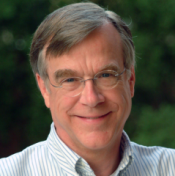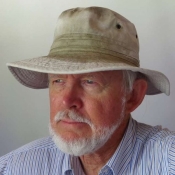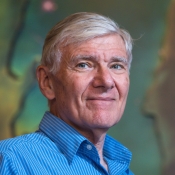Celebrating 3 faculty members who have been at ASU for 50 years or more
ASU Regent's Professor Sumner Starrfield is pictured in his office in 2015. Photo by Charlie Leight/ASU News
It’s tempting to come up with some sort of clever moniker when writing about the three Arizona State faculty members who have been at the university for at least 50 years.
The 50-3?
Three going on 50?
The half-century club?
Instead, how about we just appreciate the talent, discipline and love for their jobs that have entrenched these Sun Devils for most of their lives?
Sumner Grosby Starrfield, Regents Professor, School of Earth and Space Exploration. Hire date: July 1, 1972.
Donald Burt, professor, School of Earth and Space Exploration: Hire date: Aug. 19, 1974.
Richard Creath, President’s Professor, School of Life Sciences, School for the Future of Innovation in Society. Hire date: Aug. 19, 1974.
Their careers are as disparate as their pursuits, as is their explanation for why they came to Tempe and never left.
“It was a good place to raise a family,” Starrfield said. “I don’t know. I just never left.”
ASU News talked to the three members of the half-century club — OK, we couldn’t resist — to hear their Sun Devil stories.
Richard Creath
There was a very simple reason Creath packed up and moved to ASU in ’74 after attending graduate school at the University of Pittsburgh.
“I sometimes say that I came to Arizona for the food,” Creath said. “I like to eat, and they offered me a job.”
Creath, who was hired on a tenure track line as a philosophy professor, knew little to nothing about Arizona before his arrival. Google wasn’t available, and whatever information Creath did find turned out to be false.
As he drove into the Valley that August, he quickly discovered that Arizona was, well, a bit different.
“I had what little I possessed in a borrowed station wagon, and I was driving down I-17, which had recently been opened,” Creath said. “And apparently, they didn’t know how to pour concrete in temperatures like this, so it was like driving over a washboard road. It was so bumpy I thought I had a flat tire.”
Creath settled into an apartment at Broadway and Priest roads in Tempe and rode his bike past feedlots on his way to ASU. Like most young professionals, he didn’t have his career planned out. Staying at ASU for 50 years wasn’t even a consideration for the then 27-year-old.
“I think I was reasonably open to whatever happened,” he said. “I wouldn’t have said, ‘No, this isn’t possible.’ I would have said, ‘Do you have any reason to believe that will happen?’ I didn’t even know that I would like teaching. But the one thing that’s predictable about the future is that it’s unpredictable.”
Creath quickly discovered that he loved teaching — “I enjoy exploring ideas with students,” he said — and as the Valley grew and ASU shed its image as a party school, he felt less inclined to leave, even after job opportunities opened up at several universities, including Stanford.
“ASU was not a prominent place to do academic research (in ’74),” Creath said. “At that time, the University of Arizona had an excellent philosophy department. But that quality of research that’s done here is probably the most important change that’s taken place.”
Creath doesn’t know how much longer he’ll teach and continue his research — he has had dozens of articles published, including “The Role of History in Science,” and “The Construction of Reason” — but as he sees it, why have an end date in mind when you’re still capable and enjoy what you do?
“Money is not the primary motive,” he said. “I’m still growing and still thinking about things as much as I ever have.”
Donald Burt
So, how does a guy with two degrees from Harvard and a third from Princeton wind up at ASU in the summer of 1974?
He has his parents to thank.
When Burt was in high school, his parents took him on a trip out West that included a stop in Arizona. Burt “fell in love” with the idea of shedding the East Coast, and in 1969, while pursuing his PhD in geological sciences at Harvard, he learned that ASU Professor Peter Buseck, now an emeritus professor in the School of Molecular Sciences, would be conducting a field trip to mines in Arizona.
Burt arranged to be part of the field trip, Buseck gave him a tour of the campus, and several years later — after stops in Washington, D.C., Holland and Yale — Burt passed on a chance to live and work in Hawaii to become an assistant professor at ASU, in part because the “whole area is paradise for a geologist.”
“It really was a wonderful opportunity,” Burt said. “I still feel that way.”
Burt, an economic geologist with experience in mineralogy, petrology and geochemistry, said he loved that ASU was growing and uninhibited in imagining what it could become, even if its reputation in the 1970s was not quite as academic as it is today.
“It was not in the least bit stagnant, like, frankly, the Ivy League was, even back then,” he said. “But for 20 years, I kept correcting professionals in my field, saying, ‘No, I’m not from the UofA in Tucson.’
“Nobody makes that mistake now.”
Although teaching methods have changed in Burt’s 50 years at ASU — “it’s a lot more online and a lot more computer intensive,” he said — the connection between teacher and student is as fulfilling to him today as it was in ’74.
“They are still inquisitive 19- and 20-year-olds,” he said. “They’re fundamentally still young people interested in exploring life. I will say there were a lot more interactions between faculty and students over a beer back then. Now, it’s more likely to be over coffee or a cake or something.”
Burt said he’s “amazed” at the progress ASU has made since Michael Crow became president in 2002.
“It’s a good place to be associated with,” he said. “People have heard of us now.”
Sumner Grosby Starrfield
If someone had told Starffield he’d still be at ASU teaching 52 years after arriving in Tempe, he would have had a two-word response: “You’re crazy.”
But here Starrfield remains, teaching Introduction to Astronomy courses to first-year students and continuing his research of stellar explosions. Sort of, you know, the ideal work for a computational astrophysicist named Starrfield.
In 1972, Starrfield thought ASU was located in Phoenix. The mistake was understandable. He was a faculty member at Yale for four years before taking a job at IBM. Phoenix, Tempe — it was all the same.
“It didn’t seem like there was that much of a difference back then,” he said.
When one spends more than 50 years at the same place, they’re bound to see changes — some significant, some not. Starrfield said the positive transformation he has seen at ASU has come in the last 20 years under Crow’s leadership.
“A lot of things have changed, I think, to the good,” he said. “I am a very strong supporter of what Michael has accomplished.”
One of those accomplishments that has altered Starrfield’s teaching career is ASU’s commitment to being an inclusive university that accepts students from all walks of life, not just those with a high grade-point average.
Knowing that some students may not have any sort of science background or a basic knowledge of astronomy, Starrfield has shifted his focus to teaching an Introduction to Solar Systems Astronomy class.
“These are people that may never take another science class, and I feel that I have something to offer them as a practicing research scientist,” he said. “I’m doing a lot more show and tell, describing things in more general ways to establish things they are familiar with. For example, when I talk about telescopes, I also talk about how cameras work.
“I skip some of the more technical stuff I used to do, but hopefully they’ll remember what I’ve told them about cameras when they go take a picture. It’s a new method, but I really enjoy what I’m doing.”
And, even after 52 years, he has no plans on stopping.
“I don’t have a plan B,” he said. “I mean, if I’m going to retire and continue doing all the research that I’m doing, why shouldn’t I get paid for it?”
More Sun Devil community

Open Doors report: ASU’s doors are open to the world
For the fourth straight year, Arizona State University is being recognized as the top public university choice of international students by the Institute of International Education in its annual…

ASU students receive $25,000 scholarships from NBA legend Magic Johnson
By Henry Smardo Serenity Reynolds Cronkite student Serenity Reynolds balances classes, homework, clubs, internships and jobs, and tuition is always top of mind. She…

ASU Accessibility Awareness Day advocates for a more inclusive digital future
By Jonathan CrowellAs technology continues to drive learning and research innovations, so do efforts to ensure digital products and environments are accessible by all.Last week, Arizona State…


